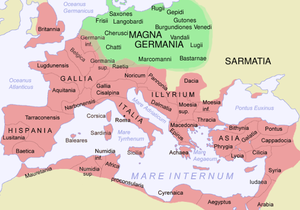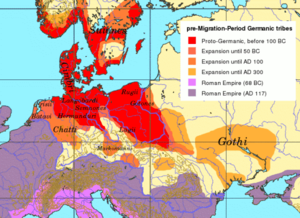Germania: Difference between revisions
m →History: avoid redirect |
m →History: avoid redirect (again, sorry) |
||
| Line 7: | Line 7: | ||
==History== |
==History== |
||
Germania was inhabited by different tribes, mostly [[Germanic |
Germania was inhabited by different tribes, mostly [[Germanic peoples|Germanic]] but also including [[Celts|Celtic]], [[Baltic peoples|Baltic]], [[Slavs|Slavic]] and [[Scythia|Scythian]], or steppe elements. Though Germanic tribes were in the majority, the ethnic makeup was complex and changed over the centuries as a result of [[human migration|migrations]]. The Germanic people spoke [[Proto-Germanic]] dialects. |
||
The Classical world knew little about the people who inhabited the north of Europe before the second century BC. In the fifth century BC the Greeks were aware of a group they called Keltoi (Celts). [[Herodotus]] also mentioned the Scythians, but no other barbarian tribes. At around 320, [[Pytheas]] of [[Marseille|Massalia]] sailed around [[Roman Britain|Britain]] and along the northern coast of Europe, and what he found on his journeys were so unbelievable that later writers refused to believe him. He may have been the first Mediterranean to distinguish the Germanic people from the Celts. [[Caesar]] described the cultural differences between the Germanic tribesmen, the Romans and the Gauls. He said that the Gauls, although warlike, could be civilized, but the Germanic tribesmen were far more savage, and were a threat to Roman Gaul, and so had to be conquered. His accounts of barbaric northern tribes could be described as an expression of the superiority of Rome. |
The Classical world knew little about the people who inhabited the north of Europe before the second century BC. In the fifth century BC the Greeks were aware of a group they called Keltoi (Celts). [[Herodotus]] also mentioned the Scythians, but no other barbarian tribes. At around 320, [[Pytheas]] of [[Marseille|Massalia]] sailed around [[Roman Britain|Britain]] and along the northern coast of Europe, and what he found on his journeys were so unbelievable that later writers refused to believe him. He may have been the first Mediterranean to distinguish the Germanic people from the Celts. [[Caesar]] described the cultural differences between the Germanic tribesmen, the Romans and the Gauls. He said that the Gauls, although warlike, could be civilized, but the Germanic tribesmen were far more savage, and were a threat to Roman Gaul, and so had to be conquered. His accounts of barbaric northern tribes could be described as an expression of the superiority of Rome. |
||
Revision as of 20:20, 29 July 2006
- For alternate meanings see Germania (disambiguation)

'Magna Germania' in the early 2nd century.

Dating back to the Roman era, Germania was the Latin name for a geographical area that stretched from the west bank of the Rhine to a vaguely-defined eastern frontier with the forest and steppe regions of modern Russia and Ukraine (Sarmatia). It is now used to refer to a region of northern and central Europe consisting of Germanic language-speaking countries.
History
Germania was inhabited by different tribes, mostly Germanic but also including Celtic, Baltic, Slavic and Scythian, or steppe elements. Though Germanic tribes were in the majority, the ethnic makeup was complex and changed over the centuries as a result of migrations. The Germanic people spoke Proto-Germanic dialects.
The Classical world knew little about the people who inhabited the north of Europe before the second century BC. In the fifth century BC the Greeks were aware of a group they called Keltoi (Celts). Herodotus also mentioned the Scythians, but no other barbarian tribes. At around 320, Pytheas of Massalia sailed around Britain and along the northern coast of Europe, and what he found on his journeys were so unbelievable that later writers refused to believe him. He may have been the first Mediterranean to distinguish the Germanic people from the Celts. Caesar described the cultural differences between the Germanic tribesmen, the Romans and the Gauls. He said that the Gauls, although warlike, could be civilized, but the Germanic tribesmen were far more savage, and were a threat to Roman Gaul, and so had to be conquered. His accounts of barbaric northern tribes could be described as an expression of the superiority of Rome.
The most complete account of Germania that has been preserved from Roman times is Tacitus' Germania.
Regions
Germania was defined by Rome as having two regions: 'the inner Germania', west and south of the Rhine, occupied by the Romans, and 'the big Germania' (Magna Germania) east of the Rhine. The occupied Germania was divided into two provinces: Germania Inferior (approximately corresponding to the southern part of the present-day Low Countries) and Germania Superior (approximately corresponding to present-day Switzerland and Alsace).
See also
External links
References
Malcolm Todd (1995). The Early Germans. Blackwell Publishing.
